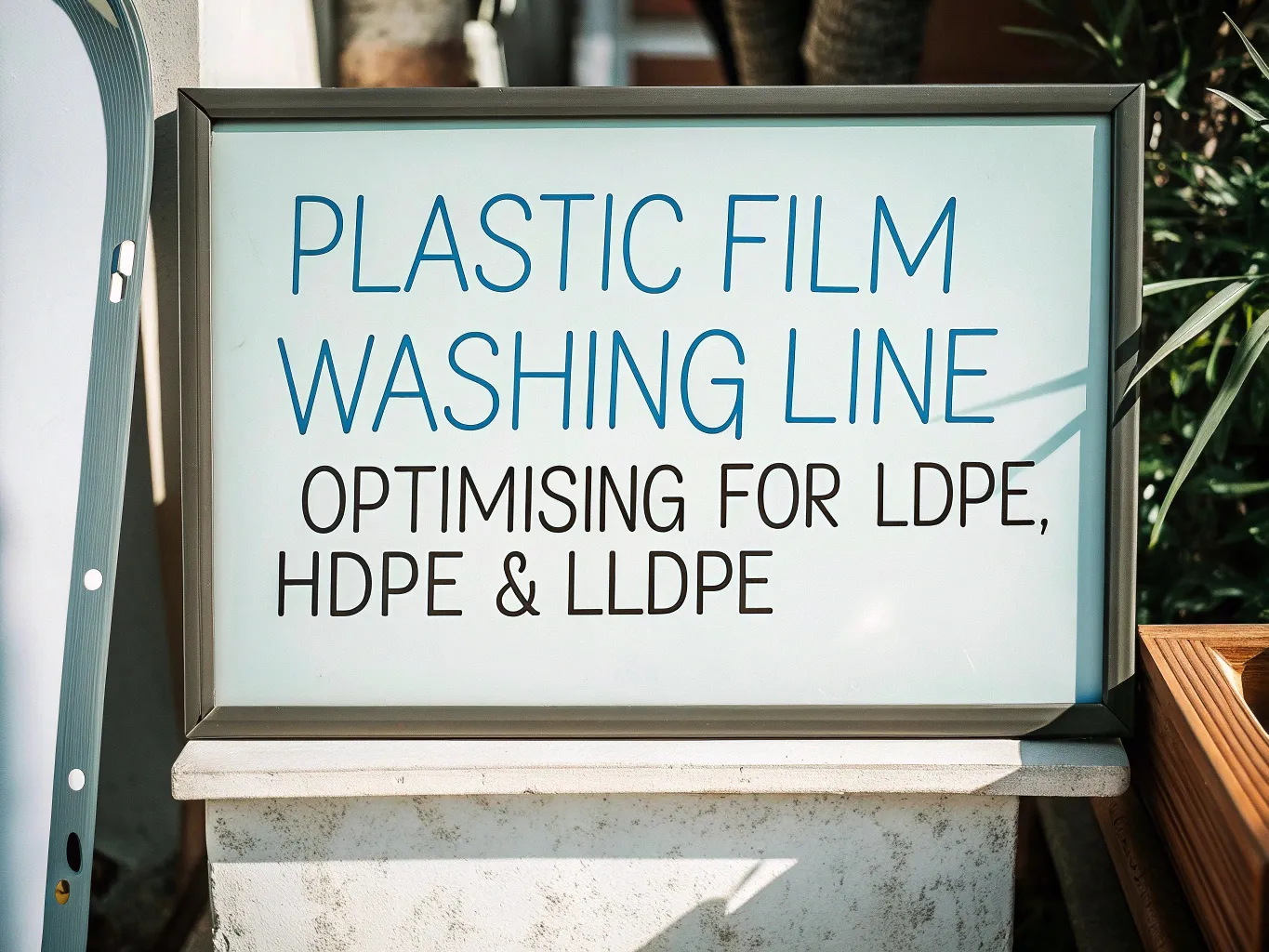Polyethylene (PE) film is a cornerstone of modern packaging and industry, from the ubiquitous shopping bag and food wrap to agricultural sheeting and industrial stretch film. As the drive towards a circular economy intensifies, recycling this vast stream of PE film is not just environmentally desirable, but economically crucial.
However, the journey from soiled post-consumer or post-industrial film to high-quality recycled pellets hinges significantly on one critical phase: washing. An effective plastic film washing line is the engine room of quality recycling, yet achieving optimal results requires a nuanced understanding. Different types of PE film – primarily Low-Density Polyethylene (LDPE), High-Density Polyethylene (HDPE), and Linear Low-Density Polyethylene (LLDPE) – possess distinct characteristics and encounter varied contaminants, demanding tailored approaches within the washing process. This article delves into these differences and explores how to optimise your plastic film washing line accordingly.
Why Effective Washing is Non-Negotiable
Before comparing film types, let’s establish why a high-performance plastic film washing line is fundamental:
- Guarantees Recyclate Quality: Residual contaminants like food waste, oils, adhesives, soil, sand, and labels drastically impair the physical properties, colour, odour, and ultimately the value and application range of the final recycled PE pellets.
- Enhances Processing Efficiency: Dirty or improperly cleaned film can clog shredders, wear down extruder screws, cause blockages, and lead to increased downtime and maintenance costs throughout the recycling plant.
- Ensures Environmental Compliance: Efficient washing lines are designed to minimise water consumption through recycling systems and must integrate with appropriate wastewater treatment processes to meet discharge regulations.
Understanding the Feedstock: A Brief on PE Film Types
A basic grasp of the materials entering your plastic film washing line is essential:
- Low-Density Polyethylene (LDPE): Soft, flexible, typically transparent, with good toughness but lower strength. Common in food packaging films, carrier bags, shrink wrap, and bin liners.
- High-Density Polyethylene (HDPE): More rigid, stronger, often opaque or translucent, with excellent chemical resistance. Used for heavier-duty bags (e.g., bags-for-life), crate liners, and some agricultural films (like geomembranes).
- Linear Low-Density Polyethylene (LLDPE): Offers superior tensile strength, puncture resistance, and elongation compared to LDPE. Widely used in stretch wrap, agricultural greenhouse films, heavy-duty sacks, and as a layer in composite films.
Anatomy of a Typical Plastic Film Washing Line
While specific configurations vary, most plastic film washing lines incorporate several key stages designed to systematically remove contamination:
- Size Reduction (Shredding/Crushing): Reduces the film into smaller, more manageable flakes for efficient washing. The method and flake size can impact subsequent stages.
- Pre-washing/Rinsing: Initial removal of loose dirt, sand, and superficial contaminants, often using cold water.
- Friction Washing (Hot or Cold): The core cleaning stage. High-speed paddles or screws create intense friction between film flakes in water (sometimes heated and with detergents) to scrub off ingrained dirt, labels, and adhesives.
- Sink-Float Separation: Utilises water density to separate PE films (which float) from heavier contaminants like PET, PVC, metals, glass, and sand (which sink).
- Multiple Rinsing Stages: Removes residual detergents and loosened contaminants.
- Dewatering: Mechanical methods (like screw presses or centrifuges) remove the bulk of the water.
- Thermal Drying (Optional but common): Hot air systems further reduce moisture content to levels suitable for extrusion (typically <1-5%).
Customising the Clean: Adapting the Plastic Film Washing Line for Different Films
Here’s where understanding the specific PE type becomes critical for optimising your plastic film washing line:
1. Washing LDPE Film
- Common Contaminants: Food residues, oils, organic matter, light soiling, some labels, moisture. Post-consumer LDPE often presents a wide mix.
- Key Washing Challenges:
- Softness & Flexibility: Prone to tangling and balling up in shredders and washing tanks, hindering material flow and uniform cleaning.
- Thermal Sensitivity: Can easily soften, shrink, or deform at higher temperatures, potentially leading to agglomeration.
- Organic Contamination: Requires effective removal of food waste and associated odours.
- Washing Line Considerations:
- Gentle Shredding: Aim for consistent flake size, avoiding excessive fines or long strands.
- Multi-Stage Washing: Often requires both cold and warm water (typically below 60°C) stages. Mild, environmentally friendly detergents are often necessary for grease and organics.
- Lower Friction Intensity: Adjust friction washer speed/design to prevent excessive mechanical stress and tangling. Ensure good material transport within tanks.
- Thorough Rinsing: Crucial to remove all detergent residues.
- Controlled Dewatering: Avoid excessive pressure that could compact the soft flakes.
2. Tackling HDPE Film
- Common Contaminants: Soil, sand (especially agricultural film), chemical residues (agrochemicals, industrial oils), stubborn labels, potentially heavier grime.
- Key Washing Challenges:
- Rigidity: While easier to shred, ingrained dirt or dried-on contaminants can be harder to remove.
- Specific Contaminants: Agricultural films may contain persistent pesticides; industrial films may have stubborn oils or chemicals requiring specific attention.
- Washing Line Considerations:
- Robust Shredding: Easily achievable due to material stiffness.
- Intensive Pre-washing: Essential for films with high soil/sand content (e.g., using a trommel screen).
- High-Intensity Friction Washing: HDPE can withstand more aggressive mechanical scrubbing.
- Hot Washing Potential: Effectively removes oils and grease. Washing temperatures between 60-85°C, often with alkaline detergents, are common for heavily soiled material.
- Targeted Chemical Treatment (Use with Caution): For specific, persistent chemical residues, specialised (and environmentally assessed) cleaning agents might be needed.
- Effective Rinsing: Ensure complete removal of detergents and contaminants.
3. Challenges with LLDPE Film
- Common Contaminants: Soil, dust (agricultural film), inherent tackiness or residual adhesives (stretch wrap), labels, some oils.
- Key Washing Challenges:
- Stretchiness & Tackiness: Extremely prone to tangling and wrapping around rotating equipment (shredder rotors, washer shafts). Stretch films can retain significant surface moisture. Additives (like tackifiers) can complicate cleaning.
- Agricultural Film Burden: Large surface area often means high levels of embedded soil and UV degradation, making cleaning difficult.
- Washing Line Considerations:
- Controlled Shredding: Critical to achieve a flake size that minimises wrapping and tangling issues. Specialised shredder designs may be beneficial.
- Intensive Pre-washing: Vital for heavy soil loads on agricultural LLDPE.
- Optimised Friction & Rinsing: Requires sufficient mechanical action and water flow to overcome tackiness and release dirt, potentially across multiple stages.
- Careful Temperature Control: Generally washed in warm water; excessively high temperatures can exacerbate stickiness and softening.
- Additives Consideration: Tackifiers or other additives might require specific detergent formulations or slightly higher temperatures to manage.
- Efficient Dewatering: Due to its nature, LLDPE flakes can trap more water; efficient mechanical dewatering is key before thermal drying.
Fine-Tuning Your Process: Other Key Optimisation Factors
Beyond the specific PE type, tailoring your plastic film washing line operation involves considering:
- Level and Type of Contamination: Heavily soiled materials require more intensive washing stages, potentially higher temperatures, and specific detergents.
- Required Output Quality: The intended end-use of the recycled pellets (e.g., high-grade film extrusion vs. lower-grade injection moulding) dictates the necessary cleanliness level.
- Washing Line Configuration: The specific machines (types of washers, number of stages, separation efficiency) available will influence achievable results.
- Cost-Effectiveness: Balancing water, energy, and detergent consumption against throughput and final pellet quality is essential.
- Environmental Regulations: Stringent wastewater discharge limits necessitate effective water treatment and recycling systems integrated with the washing line.
Conclusion: The Path to High-Quality Recycled PE Film
Successfully recycling PE films into valuable secondary raw materials is impossible without effective cleaning. A well-designed and properly operated plastic film washing line is central to this success. However, a ‘one-size-fits-all’ approach falls short. Recognising the distinct properties and contamination profiles of LDPE, HDPE, and LLDPE allows recyclers to “customise the clean” – adjusting shredding parameters, washing temperatures, friction intensity, detergent use, and residence times. By tailoring the washing process within the capabilities of their plastic film washing line, businesses can significantly improve contaminant removal, boost the quality of their recycled pellets, increase operational efficiency, and ultimately contribute more effectively to a sustainable circular economy for plastics.


